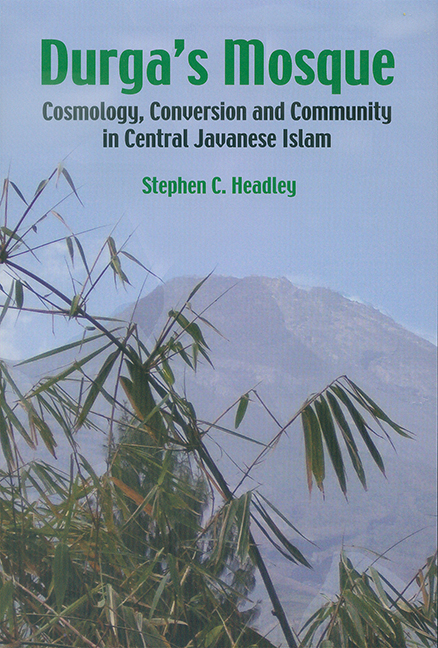Book contents
- Frontmatter
- Contents
- List of Figures
- List of Tables
- Preface
- Acknowledgements
- Introduction: Cosmology, Conversion and Community in Javanese Islam
- PART I THE SOCIOLOGY AND PRACTICE OF RELIGION IN CENTRAL JAVA
- PART II RECONSTRUCTION OF LOCAL RELIGIOUS HISTORY
- PART III INVOKING THE COSMOS, MAGNIFYING ALLAH: STRUCTURING A LANDSCAPE IN THE SEVENTEENTH TO NINETEENTH CENTURIES
- 7 The Khandava Forest in India and Its Javanese Demon Queen
- 8 The Spearing of Durga's Buffalo
- 9 Invoking the Goddess Durga; Worshipping Allah
- 10 The Javanization of Islamic Prayer; The Islamization of Javanese Prayer
- 11 Javanese Cosmologies and Muslim Cosmographies: An Encompassing Knowledge?
- PART IV COSMOLOGY, CONVERSION AND COMMUNITY IN CENTRAL JAVANESE ISLAM TODAY
- Bibliography
- Index
- About the Author
7 - The Khandava Forest in India and Its Javanese Demon Queen
from PART III - INVOKING THE COSMOS, MAGNIFYING ALLAH: STRUCTURING A LANDSCAPE IN THE SEVENTEENTH TO NINETEENTH CENTURIES
Published online by Cambridge University Press: 21 October 2015
- Frontmatter
- Contents
- List of Figures
- List of Tables
- Preface
- Acknowledgements
- Introduction: Cosmology, Conversion and Community in Javanese Islam
- PART I THE SOCIOLOGY AND PRACTICE OF RELIGION IN CENTRAL JAVA
- PART II RECONSTRUCTION OF LOCAL RELIGIOUS HISTORY
- PART III INVOKING THE COSMOS, MAGNIFYING ALLAH: STRUCTURING A LANDSCAPE IN THE SEVENTEENTH TO NINETEENTH CENTURIES
- 7 The Khandava Forest in India and Its Javanese Demon Queen
- 8 The Spearing of Durga's Buffalo
- 9 Invoking the Goddess Durga; Worshipping Allah
- 10 The Javanization of Islamic Prayer; The Islamization of Javanese Prayer
- 11 Javanese Cosmologies and Muslim Cosmographies: An Encompassing Knowledge?
- PART IV COSMOLOGY, CONVERSION AND COMMUNITY IN CENTRAL JAVANESE ISLAM TODAY
- Bibliography
- Index
- About the Author
Summary
The passage of time has left its mark on the structure of inhabited space around Kaliasa but nowhere more than in the former forest of Krendawahana. A once free-floating toponym, now attached to the south back of the Cemara River, evokes in the minds of the Javanese peasant a whole series of associations deriving from oral literature and the wayang. Denys Lombard has summarized the aura of Javanese sacred forests (alas angker) and the typically Javanese vision of the forest found in literature (1974, p. 478; translation S.C. Headley):
… the echo of a society in the process of change which seeks to disengage itself from its ecological context felt to have become outmoded, a society which is elaborating its own notion of “savagery”. The opposition between a cleared, cultivated and domesticated space as opposed to savage, primitive, dangerous space. Yet at the same time the ambivalence of the forest where there continue to live in front line position constituted by hermitages, those replaceable supernatural forces which only the resi (seers) know how to reconcile, and which any true hero must provoke and dominate if he wants to profit in the valleys from the esteem of his fellows.
On the other hand the forest as a school of nature, the inspiration of the poet, so important in India, gained wide favour in the Javanese court literature known as kawi (Zoetmulder 1974, pp. 163–64). This explains how the toponym of Kha–ndava (i.e., Krendawahana) appeared in the Javanese late tenth-century prose translation of the Ādiparwa, the first volume of the immense Indian epic of the Mahābhārata. This old Javanese text, with a dedication (manggala) to Siwa, derives from one north Indian version of the Mahābhārata. In Javanese it has been reduced to about 36 per cent of its original length in Sanskrit. Each part (parva) translated individually into Javanese varies in different proportions from its Sanskit original.
- Type
- Chapter
- Information
- Durga's MosqueCosmology, Conversion and Community in Central Javanese Islam, pp. 251 - 281Publisher: ISEAS–Yusof Ishak InstitutePrint publication year: 2004



